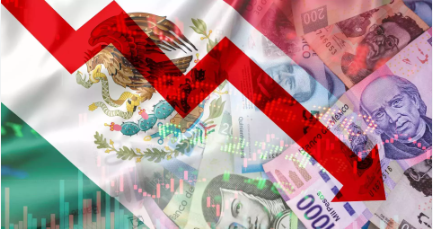Mexico, a nation known for its vibrant culture and rich history, is currently facing an economic storm that has left many feeling uneasy. From bustling cities to quiet towns, the effects of this downturn are palpable. Citizens are worried about their livelihoods, while businesses struggle to keep their doors open amid uncertainty. Understanding how we got here and what it means for our future is crucial.
As we delve into the current state of Mexico’s economy, we’ll explore the factors contributing to this crisis and examine its impact on both individuals and enterprises alike. But it’s not all doom and gloom; there are steps you can take to manage your finances during these challenging times. Join us as we navigate through the complexities of this situation—armed with information that empowers you towards better financial decisions in an unpredictable landscape.
The current economic situation in Mexico
The current economic https://finanzasdomesticas.com/economia-de-mexico-afectada situation in Mexico is marked by uncertainty and challenges. Following a period of growth, the country has experienced significant setbacks due to various external and internal pressures.
Inflation rates have surged, leading to higher costs for everyday goods. Many families are feeling the pinch as prices rise faster than wages can keep up. This imbalance affects purchasing power and overall quality of life for countless citizens.
Additionally, unemployment remains a concern. While some sectors show resilience, others struggle with layoffs and reduced hours. Small businesses face an uphill battle against rising operational costs while trying to attract consumers who have tightened their budgets.
Foreign investments are also wavering as investors reassess risks amid global economic shifts. These factors create a volatile environment that makes it difficult for both individuals and companies to plan for the future with confidence.
Factors contributing to the country’s economic downturn
Several factors are causing Mexico’s economic https://finanzasdomesticas.com/economia-de-mexico-afectada downturn. The global pandemic disrupted supply chains, leading to significant job losses and reduced consumer spending.
Inflation has also surged in recent months. Rising prices on basic goods strain household budgets, forcing families to make tough choices. This situation creates a ripple effect across various sectors.
Additionally, political instability has contributed to uncertainty among investors. Lack of confidence can deter foreign investment, which is crucial for growth.
Trade agreements have faced challenges as well. Changes in policies and tariffs can impact exports and imports significantly.
Natural disasters have further complicated recovery efforts. Hurricanes and earthquakes disrupt local economies just when they need stability the most. Each of these elements intertwines, creating a complex web that hampers progress in the nation’s economy.
Impact on businesses and citizens
The economic downturn in Mexico has cast a long shadow over both businesses and ordinary citizens. Many small enterprises have struggled to stay afloat, facing dwindling sales and increased costs. This creates an environment where layoffs become inevitable.
Citizens are feeling the pinch more than ever. With rising unemployment rates, many families are finding it hard to cover basic needs like food and housing. The strain on household budgets is palpable as people tighten their belts.
Consumer confidence is wavering, leading to reduced spending habits across various sectors. Local markets that once thrived now see fewer customers browsing their aisles.
On the flip side, some companies have adapted by innovating their offerings or embracing digital solutions. However, these shifts often come too late for those already teetering on the edge of bankruptcy.
Government response and policies
The Mexican government has implemented a range of measures to address the current economic challenges. These policies aim to stimulate growth and provide relief to those affected by the downturn.
One key initiative focuses on financial support for small businesses. This includes loans with favorable terms and grants designed to help companies weather the storm. By supporting local enterprises, officials hope to preserve jobs and maintain consumer spending.
Additionally, social programs have been expanded. The government is increasing aid for vulnerable populations, ensuring that basic needs are met during these tough times. This strategy not only alleviates immediate hardships but also fosters long-term stability.
Furthermore, tax incentives are being introduced to encourage investment in critical sectors like technology and infrastructure. Such efforts could enhance competitiveness while stimulating job creation across various industries.
Through these multifaceted approaches, authorities strive to navigate the challenging economic landscape effectively.
Tips for managing personal finances during an economic crisis
Navigating personal finances during an economic crisis requires a strategic approach. Start by reviewing your budget. Identify essential expenses and cut non-essential spending.
Establishing an emergency fund can provide a safety net. Aim for at least three to six months of living expenses saved up. This cushion will help you weather unexpected challenges.
Consider diversifying your income streams. Freelancing or part-time work can supplement your primary source of income, offering more financial stability.
Stay informed about available resources such as government assistance programs or community support services that might be beneficial during tough times.
Also, don’t hesitate to communicate with creditors if you’re facing difficulties in making payments; many lenders are willing to negotiate terms during economic downturns.
Focus on long-term goals while remaining adaptable in the short term. Flexibility is key when navigating uncertain financial waters.
Long-term effects of the economy on Mexico
The long-term effects of the current economic situation in Mexico can reshape various aspects of society. Job losses and business closures may lead to a significant increase in poverty levels. This could result in a wider gap between the rich and poor, affecting social stability.
Education systems might suffer as funding becomes scarce. Families may prioritize immediate needs over schooling, impacting future generations’ opportunities.
Additionally, consumer behavior will likely shift as people become more cautious with their spending habits. Businesses that adapt quickly could thrive while others struggle to recover.
Investment in technology and infrastructure could be delayed, hindering progress for years to come. The economy’s recovery path is crucial for rebuilding trust among citizens and investors alike.
Long-term resilience hinges on how well both government policies and individual strategies are implemented during these challenging times.
Conclusion: Hope for a better future
The current economic landscape in Mexico presents challenges, but it also fosters resilience and innovation. As the country navigates these turbulent waters, there is a palpable sense of determination among its citizens and businesses alike. With supportive government policies aiming to stimulate growth and the adaptability of local enterprises, there are signs that recovery is possible.
Citizens can take proactive steps to safeguard their financial well-being during tough times. Budgeting wisely, seeking alternative income sources, and investing in skill development are effective strategies for weathering an economic storm.
While the short-term outlook may seem daunting, history shows that economies have a remarkable ability to rebound. The strength found in community support and shared resources plays a crucial role in fostering hope.
Optimism remains vital as Mexico faces its economic hurdles head-on. Together with strategic planning and collaborative efforts, brighter days lie ahead for this vibrant nation.

